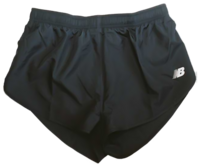
Summary
Running shorts are a specialized form of shorts worn by runners.[1][2][3][4][5] Often the cut of a running short is quite short, this is done in order to maximise breathability and movement, and to ensure the pant does not catch on the runners knee.[citation needed]

Materials edit
Running shorts are designed to facilitate comfort and free movement during exercise. Their materials are lightweight and hard-wearing. Many running shorts include an inner lining that acts as underwear, so wearing separate underwear is not necessary. Polyester is a common fabric in running shorts and makes it comfortable.[citation needed]
Variants edit
Many running shorts have a seam cut up the side of each leg to enable freer movement. Manufacturers define running shorts according to the length of the leg which is not cut. For example, a 3/4 seam means that 1/4 of the length is cut.[citation needed]
- 1/2 split seam shorts are the shortest.
- 3/4 split seam shorts are short, but not as short as 1/2 split seam shorts.
- Square leg shorts have no split at all.
Longer shorts are not ideal for running. A runner's stride may pull up the shorts' fabric, which can cause discomfort. Nonetheless, some runners prefer longer shorts because they cover a greater portion of their legs.
Some runners use athletic hot pants as running shorts. Like 1/2 split seam shorts, hot pants do not encumber leg movement.
Lycra running shorts are an alternative to conventional, polyester-based shorts. In most cases, they reach the mid-thigh. They are skin-tight, so they allow for more flexible, unencumbered movement.
See also edit
References edit
- ^ Drenth, Tere Stouffer (2011-05-04). Marathon Training For Dummies. John Wiley & Sons. ISBN 978-1-118-06872-4.
- ^ Official Gazette of the United States Patent and Trademark Office: Trademarks. U.S. Department of Commerce, Patent and Trademark Office. 2004. p. 397.
- ^ Meghan, Hicks; Bryon, Powell (2016-03-07). Where the Road Ends: A Guide to Trail Running. Human Kinetics. pp. 71, 112, 194. ISBN 978-1-4925-1328-5.
- ^ All About of Fitness. Lulu.com. p. 9. ISBN 978-0-557-01194-0.
- ^ David, Magida; Melissa, Rodriguez (2016-08-29). The Essentials of Obstacle Race Training. Human Kinetics. p. 32. ISBN 978-1-4925-1377-3.


